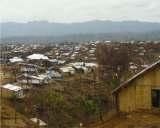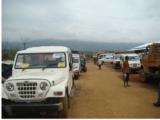Archives
The Return Of The Brus
 The repatriation of Brus, who sought shelter in Tripura in 1997, was suspended in November 2010, following protests by some Bru forums. The ACHR Director Chakma facilitated a dialogue between the pro- and anti-repatriation factions of the displaced Brus at Kanchanpur in December 2010. Both the parties agreed to support the process of repatriation once the Central Government decided to offer financial aid, under a special project for the sustainable development of the returnee Brus.
The repatriation of Brus, who sought shelter in Tripura in 1997, was suspended in November 2010, following protests by some Bru forums. The ACHR Director Chakma facilitated a dialogue between the pro- and anti-repatriation factions of the displaced Brus at Kanchanpur in December 2010. Both the parties agreed to support the process of repatriation once the Central Government decided to offer financial aid, under a special project for the sustainable development of the returnee Brus.
Thus emerged the Kanchanpur Agreement and, along with the Central Government, the Governments of Tripura and Mizoram, as well as the Union Home Ministry were also involved in the process. The Central Government has already allocated `9.97 crore for the repatriation process. R R Jha, Joint Secretary (North East) of the Union Home Ministry, in a letter dated 5th January 2011, informed the ACHR Director that along with `80,000 cash assistance, one year free ration will also be provided to each Bru family.
 There are about 30,000 remaining Bru (comprising over 5000 families) internally displaced people in the camps. They have already agreed to return to their homes in Mizoram, owing to the assurance given by the Central Government.
There are about 30,000 remaining Bru (comprising over 5000 families) internally displaced people in the camps. They have already agreed to return to their homes in Mizoram, owing to the assurance given by the Central Government.
The Brus have been living in miserable conditions in the relief camps in Tripura since October 1997. Over 40,000 Bru Janajati people left their homes due to the violence. Since then, they are taking shelter in six camps in northern Tripura.
 The Brus with a total population of about 435,000, as per the 2001 census are spread in Tripura, Mizoram, Assam, as well as in some parts of Bangladesh, and are recognized as Scheduled Tribes. The exodus of Brus was prompted by a demand for an autonomous district council for the socio - economic and political benefits of Brus in Mizoram. Some politically conscious Brus organized a meeting in September 1997 and raised the demand for an autonomous council in the Bru inhabited areas of Mizoram, in the hope of getting specific administrative, judicial, and legislative powers.
The Brus with a total population of about 435,000, as per the 2001 census are spread in Tripura, Mizoram, Assam, as well as in some parts of Bangladesh, and are recognized as Scheduled Tribes. The exodus of Brus was prompted by a demand for an autonomous district council for the socio - economic and political benefits of Brus in Mizoram. Some politically conscious Brus organized a meeting in September 1997 and raised the demand for an autonomous council in the Bru inhabited areas of Mizoram, in the hope of getting specific administrative, judicial, and legislative powers.
Mizoram, with nearly one million population, already has three autonomous district councils, under the Sixth Schedule of the Indian Constitution, namely Lai Autonomous District Council, Mara Autonomous District Council, and Chakma Autonomous District Council. On this basis, the demand for a Bru Autonomous District Council was rejected by both the Mizoram Government as well as the Mizo civil society groups. While the majority of the Mizo civil society groups, including Young Mizo Association (YMA) and Mizo Zirlai Pawl, expressed their anger against the Bru community, the Brus maintained their demand. This widened the rift between the two communities.
Meanwhile, the emergence of the Bru National Liberation Front (BNLF) added more complications to the situation. This armed group started disruptive activities, and was held responsible for murdering a Mizo forest guard in Mamit in October 1997. In retaliation, a section of the Mizo people carried out massive violence against the Brus, which forced thousands of Brus to leave Mizoram. Another 5000 Brus had to flee Mizoram in November 2009, following the alleged murder of a Mizo youth by Bru militants in the same district, and join the makeshift camps in Tripura.
Since then, a series of discussions among various parties, including the BNLF, various forums of displaced Bru people, the Governments of Mizoram and Tripura, the Central Government, and human rights groups, took place from time to time. Following the invitation of the Mizoram Government, a fact finding team of the ACHR visited the affected areas and met political leaders, including Chief Minister Lalthanhawla, high profile officials, and civil society groups. The team, chaired by Milon Kothari, former UN Special Rapporteur on the Right to Adequate Housing, and comprising of Suhas Chakma, ACHR Director; Nava Thakuria, writer of the article; and Bamang Tago, Chief of Arunachal Citizens Rights, as members completed the mission after visiting Mizoram and Tripura during the 14th of December 2009. In February 2010, the Union Home Ministry requested the ACHR to use its offices to convince the displaced Bru people to return to Mizoram. Finally, the process of repatriation started gaining momentum and success to some extent.
|
The Brus have been living in miserable conditions in the relief camps in Tripura since October 1997. Over 40,000 Bru Janajati people left their homes due to the violence. Since then, they have been taking shelter in six camps in northern Tripura. |
The move has also been welcomed by the most influential Mizo organization, YMA. Speaking to this writer from Aizawl, General Secretary of Central YMA Lalbiakzuala said that YMA leaders have already expressed their willingness to cooperate with the Government in the ongoing repatriation of Bru refugees. Lalbiakzuala, however, maintained that only indigenous Bru people from Mizoram would be accepted for repatriation and “The repatriated Brus should not live in a single village or group. Rather, they should resettle in different villages.” Meanwhile, a delegation of Brus met the Mizoram Governor, Lt Gen. M M Lakhera at Raj Bhavan in Aizawl and apprised him about the various grievances of the repatriated Bru families. Led by Elvis Chorkhy, General Secretary of the Bru Coordination Committee, the delegation also requested the Governor to take up some special development projects in the affected western Mizoram localities and open a Central School in the Mamit district.
“The resumption of repatriation of Brus is really a welcomed move. I believe that the Mizoram Government as well as the Union Home Ministry must ensure that these families are immediately resettled in their specified villages,” asserted Suhas Chakma, appealing to the Mizo civil society groups to go for continuous interactions with the Bru people.
The rights activist also expressed optimism that if all the stakeholders namely the Brus, the Mizoram Government, and the Union Government remain committed, there should not be any further obstacles in the process and, as Chakma says, “If repatriation of all the displaced Brus is completed, this would constitute the largest repatriation of displaced persons of our time, facilitated by a rights group.”
Nava Thakuria

